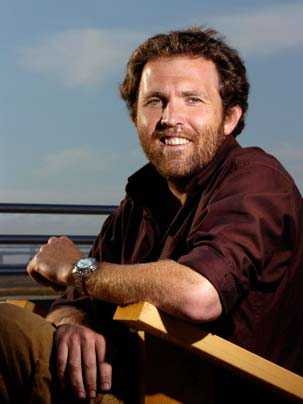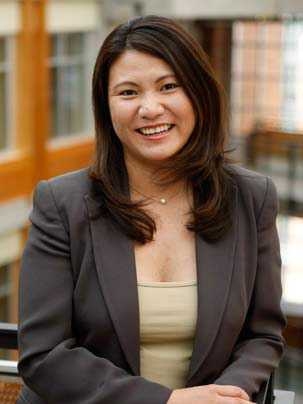MIT alumni Saul Griffith (S.M. 2001, Ph.D. 2004) and Yoky Matsuoka (S.M. 1995, Ph.D. 1998) have been awarded 2007 MacArthur fellowships, more commonly known as "genius" grants.
Griffith, an inventor who received the 2004 Lemelson-MIT Student Prize for creating a "desktop printer" that makes low-cost eyeglasses for use in underserved communities, was honored for "engineering innovations spanning optics, high-performance materials and nanotechnology in the service of the world community," according to the John D. and Catherine T. MacArthur Foundation.
Matsuoka, an associate professor and robotics expert in the Department of Computer Science and Engineering at the University of Washington in Seattle, was chosen for "devising complex prosthetic devices and rehabilitation strategies that hold life-changing potential for those suffering from brain injuries and manipulation disabilities," the foundation said.
Griffith and Matsuoka are among the 24 MacArthur fellows chosen this year for their creativity, originality and potential to make important contributions in the future. Fellows receive $500,000 in "no strings attached" support over five years; in other words, they may spend the money as they see fit.
According to The Seattle Times, the MacArthur Foundation official who notifies award winners issues a standard warning when the unsuspecting recipients pick up the phone: "I've got shocking news," he says. "If you're holding anything fragile--like a baby--you might want to set it down."
Matsuoka told the paper that she just happened to be nursing her 8-day-old son when the special call came in.
"He told me I was the very first one in 20 years who actually was holding a baby," Matsuoka, 36, was quoted as saying.
According to a biography provided by the foundation, Matsuoka is transforming experts' understanding of how the central nervous system coordinates musculoskeletal action and of how robotic technology can enhance the mobility of people with manipulation disabilities.
Working at the intersection of computer science, biophysics, material science, biomechanics, and psychophysics, Matsuoka creates sophisticated prosthetic devices and designs complementary rehabilitation strategies.
In one line of research, she constructed an anatomically correct robotic hand, complete with an intricate tendon structure that enables it to respond to sensor signals closely resembling neural commands.
This model has facilitated investigations into the neuromuscular forces necessary for precise finger movement and constitutes an important step toward the development of a dexterous prosthetic hand that can be controlled by the brain's neural signals.
Another major project Matsuoka is working on involves the use of virtual environments and visual feedback to distort recovering stroke patients' perceptions of tasks they perform during therapy.
Prior to receiving advanced degrees from MIT, she received a B.S. from the University of California, Berkeley. From 2001 to 2006, she was an assistant professor affiliated with the Robotics Institute, the Department of Mechanical Engineering, and the Center for the Neural Basis of Cognition at Carnegie Mellon University.
'Boundless energy'
According to the foundation, Griffith, 33, shares his "boundless energy" for inventing across several disciplines. Already the holder of several patents in optics, textiles, and nanotechnology, Griffith is a "prodigy of invention in service of the world community," the foundation said.
While a graduate student at MIT, Griffith designed the low-cost eyeglass maker and invented the I-cycle, a bicycle made of plywood; a 3-D chocolate printer; a 3-D micro-fabrication method for rapid construction at the nanoscale, and the e-rope, a smart rope that can sense and report the strain of the load it bears and where it has frayed.
In 2005, Time magazine named Griffith's e-rope as one of that year's 40 most amazing inventions. Also in 2005, Technology Review ranked Griffith as one of the world's 35 top innovators under the age of 35.
Griffith credits his MIT peers for inspiring him, noting that the Institute is "highly dense with people who are obsessive and passionate about what they do."
A native of Sydney, Australia, Griffith currently invents at Squid Labs, the California-based engineering/technology company he and his colleagues founded in 2004. The low-cost lenses and accessible eye-exam technologies are a major focus of research and development energy at Squid Labs, which also developed the e-rope.
As technical advisor at Potenco, a spin-off company, Griffith initiated the project design for a hand-held human-powered generator, which has the potential to improve access to electronic devices such as laptops and water purifiers throughout the world.Â
Before receiving advanced degrees from MIT, Griffith received a B.MET.E. from the University of New South Wales and an M.E. from the University of Sydney.
Griffith and Matsuoka join 29 current and former members of the MIT community who have won MacArthur Fellowships, according to the Office of the Provost. They include 13 current faculty, seven former faculty and four research staff.
A version of this article appeared in MIT Tech Talk on September 26, 2007 (download PDF).







